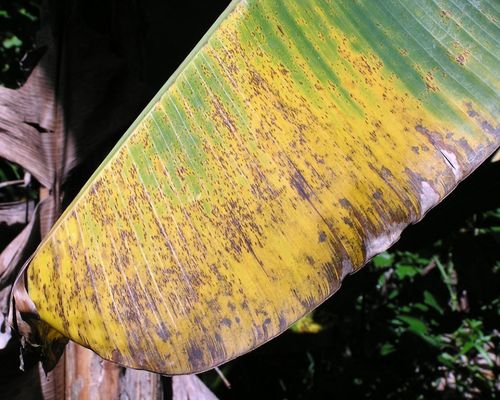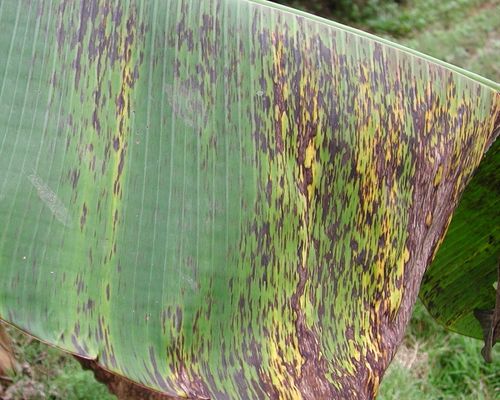This blog talks about the two types of Banana Sigatoka- yellow and black, and about their symptoms and prevention methods.
Banana plantations in broad areas are destroyed by the dangerous disease known as Sigatoka, which also causes a sharp decline in fruit production. The Sigatoka valley in Fiji was the site of the first known occurrence of this fungus-caused infestation. The prevalence of this disease has resulted in economic losses of 50% to 100% at that time.
The disease is common in South-East Asia, India, China, the southern Pacific islands, East and West Africa, the USA (Hawaii), Trinidad, Grenada (the Caribbean), and Central and South America. Additionally, it can be found on various islands in the Torres Strait and in Papua New Guinea.
Sigatoka leaf spot is one of the serious fungal diseases affecting bananas. It has become a worry for banana growers across India, particularly in Karnataka, Andhra Pradesh, Tamil Nadu, Assam, etc.
Black sigatoka vs yellow sigatoka
Black Sigatoka’s mature leaf symptoms resemble those of yellow Sigatoka, a closely related fungus that originated in Australia. Early leaf spots on black Sigatoka are longer and wider than those on yellow Sigatoka and are reddish to rusty-brown in colour. On the lower leaf surface, the marks are clearly visible.
As opposed to black Sigatoka, yellow Sigatoka’s early leaf spots are yellow-green leaf streaks that are shorter, thinner, and more noticeable on the upper leaf surface. On the same plant, both diseases may exist.
Causes of disease
- High humidity.
- Persistent leaf wetness.
- Lower temperatures.
- Closer planting of crops.
- Retaining a large number of suckers without eliminating them.
- Sigatoka disease is more likely to occur in areas with poor drainage and low soil fertility, particularly of potassium.
- Since surface moisture is necessary to propagate the disease, the disease is more severe in humid environments.
Symptoms
Yellow Sigatoka
- On the leaves, there are elliptical dots with a yellow halo around the center that are light grey in color.
- The spots frequently combine to produce sizable uneven patches of desiccated tissue.
- The defining trait of this disease is rapid drying and leaf defoliation.

Black Sigatoka
- Streaks or leaf spots are present on Black Sigatoka.
- The reddish to rusty-brown streaks are longer, wider, and darker than the common yellow Sigatoka.
- Large patches of the dead leaf may be present on plants that have the advanced form of black Sigatoka disease.

Effect of monsoon
When there is water coating on the leaves during the tropical and subtropical summers, spores of the fungus pathogen grow in large quantities. Rain is the primary way that spores are disseminated, but as time goes on, air currents have become a significant source of spore release. Leaf spotting increases in June and July, peaks in October and November, and continues to be intense into December.
Chemical control is the primary management method, and it involves the dosage-recommended application of fungicides like copper oxychloride, mancozeb, chlorothalonil, or carbendazim.
How to prevent the disease
- Elimination and destruction of the damaged leaves.
- Maintain a weed-free banana field and promptly remove suckers.
- Don’t space your plants too closely.
- To prevent water logging in the fields, which encourages infection, ensure efficient drainage.
- Cultivate resistant varieties.
- Provide sufficient potassium fertiliser.
- Keep weeds out of the fields.
- Reduce splash dispersion by using drip irrigation beneath the canopy.
- Reduce the humidity as much as possible by avoiding puddles and ensuring the crop has the best ventilation available.
How can Fasal assist?
- Sigatoka disease is most prevalent in the regions with high humidity, persistent leaf wetness, and lower temperatures. With its sensors, the Fasal AI-based system assists the farmers in managing the disease’s causes and helps them obtain a higher output for their banana plantations.
- Fasal technology is based on the concept of precision agriculture. It suggests solutions that are time, location, and crop-specific and adapted to the exact circumstances of a site in question.
- Our technology reduces the danger of infection for Sigatoka disease. Also, it monitors rainfall, humidity, temperature, canopy level forecasts, and an ultra hyper-local macroclimatic forecast to alert farmers when levels reach the optimal circumstances for disease growth.
- Fasal technology creates several management techniques and offers treatments based on the stages of disease development and the particulars of a farm.
- Our technology also provides suggestions for lowering risks and estimates the vulnerability of a farm to disease development at every stage.

Leave a comment